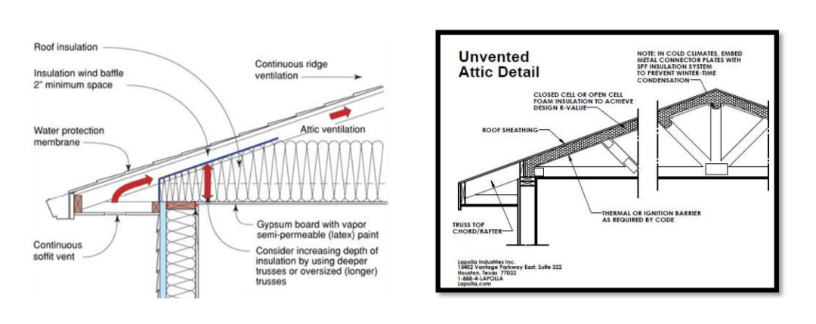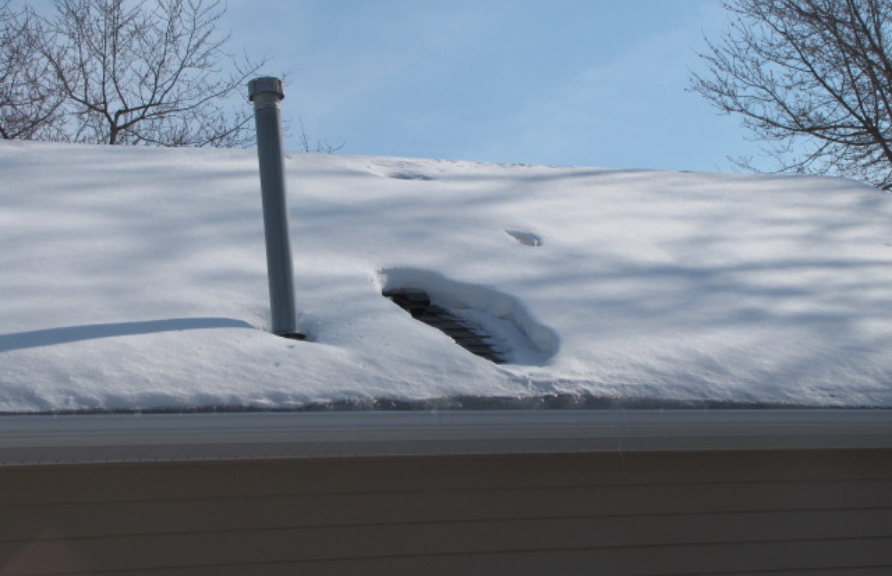Attic ventilation was designed to combat the inefficiencies insulation had on the roof deck & your living space. In the winter, the warm air that escapes through fiberglass & cellulose insulation can cause condensation on the roof deck. If this happens the moisture will become trapped in the attic and begin to rot the wood. Attic ventilation creates an air flow within the attic, which expels the warm condensation, pushing air into the outdoors. If the attic is vented properly and the insulation only has minor air leakage, the ventilation system will work as designed. A biproduct of a well-ventilated roofing system is the resolution of ice dams. Warm air that causes the condensation on the inside, is the same air the melts the snow on the outside, leading to the formation of ice dams.
Attic ventilation is trying to solve a symptom of a much larger and more expensive problem. Insulation that is allowing heat loss, is the real issue and the cause of all the problems. When ventilation is used to prevent condensation from gathering inside the attic, you are essentially venting the air from your heating system directly to the outdoors. This is extremely inefficient and expensive. A better solution is to install insulation that can prevent air leakage and moisture accumulation. Then roof deck moisture accumulation and ice dams never become problem.

Vented vs. Unvented Attics
Since the 1970’s we have become accustomed to ventilated roofing systems (vented attics). This 45-year old technique is exposing some fundamental flaws. For instance, high energy bills, cold and drafty homes or ice damming. The alternative system is using high density, closed cell spray foam directly to the roof deck eliminating the need to ventilate.
Vented Attic System: Ideally, the vented attic system is used
to remove warm, humid air from the attic, so moisture does not condensate on the bottom of the roof deck, minimizing rot of the substrate or plywood. This system can fail due to restricted or unbalanced air flow https://sdarcwellness.com/tramadol-therapy/ from the soffits, with hips, valleys or a complicated roof design. In these cases, the venting system can pull conditioned air from the living space, heat or air conditioning, you pay for. Air leakage from the living space occurs through cracks & joints in the ceiling, around electrical & plumbing penetrations, duct work or especially around recessed “can” lights. These features greatly increase the likelihood of moist air leaking into attics. When the attic ventilation is restricted, condensation can form on the underside of the roof deck. Heat loss can cause snowmelt on the roof surface, leading to ice damming and/or roof leaks and in some cases deck rot.
Unvented Attics:
When closed cell spray foam insulation is applied directly to the underside of the roof deck and gable end walls it creates an unvented attic space. When high density spray foam is greater than 2” thick, it is classified as a vapor barrier and is also air impermeable. These two aspects are the reason you do not need to ventilate. This will eliminate almost 100% of the heat loss, and completely stop all of the air loss from the conditioned space to the outdoors. The vapor barrier will stop the moisture from getting to the roof deck. The spray foam is now protecting the roof from rotting from the inside. This means we are no longer losing valuable heat or air conditioning. The highly efficient spray foam has also proven to be extremely effective against reducing solar heat gain in the summer and up to 90% elimination of ice dams due to thermal loss in the winter. The unvented attic system has far more benefits than its counterpart. It now has a confirmed track record that has held up to extreme conditions. When the older vented attic technique fails, consider the unvented roofing system for a proven final solution to ice dams or heat loss.
